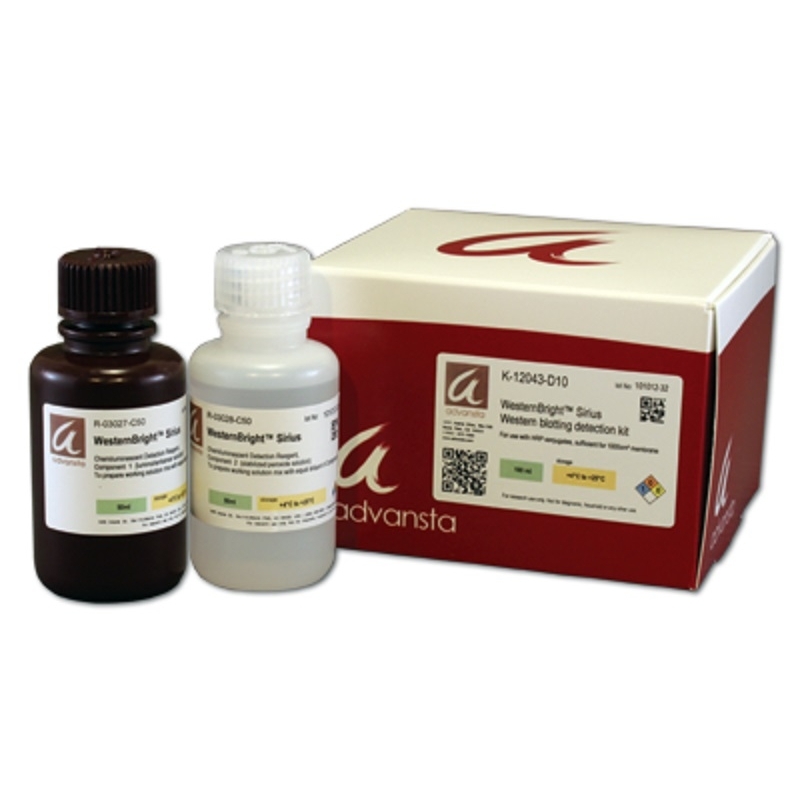- (02)28310355
- info@nautiagene.com
- Skype:Fax: 02-33229867
代理品牌

WesternBright Sirius HRP substrate
WesternBright Sirius HRP substrate
The most sensitive chemiluminescent substrate
- Most sensitive of Advansta's HRP substrates, for low-abundance proteins
- Long-lasting signal for flexible imaging
- Low background for high signal-to-noise
- Image by CCD, film, or use chemifluorescence for detection with fluorescence imagers
Includes:
WesternBright™ Sirius™Luminol/enhancer solution
WesternBright™ Peroxide Chemiluminescent Detection Reagent
產品編號:K-12043-D20
產品規格:200ml
WesternBright Sirius is the most sensitive HRP substrate available from Advansta for chemiluminescent Western blotting. With attomole sensitivity and a long-lasting signal, WesternBright Sirius allows you to detect bands not visualized with other substrates. High signal-to-noise and a large dynamic range make it ideal for quantifying low-intensity bands. And, chemifluorescence emission allows WesternBright Sirius to be imaged by chemifluorescence imagers in addition to traditional CCD imagers and film.
WesternBright Sirius is designed for sensitive detection and low antibody concentrations. With low background and a strong, long-lasting chemiluminscent and chemifluorescent signal, WesternBright Sirius is the best choice for quantifying low-abundance bands.
A.
B.
A. WesternBright Sirius provides imaging flexibility, with emitted light that can be detected using fluorescent imaging systems in addition to film and CCD based systems. A slot blot containing serial dilutions of an HRP-labeled secondary antibody was detected with WesternBright Sirius, and chemifluorescence imaged using a Typhoon imager (GE Healthcare). B. The substrate also produces a strong chemifluorescent signal that can be detected with fluorescence imagers.
A slot blot containing a serial dilution of an HRP-conjugated antibody was incubated with WesternBright Sirius, and imaged at the times indicated. After 8 hours, the bands are still easily detected with a 2 minute exposure.
WesternBright Sirius provides sensitive detection combined with extremely low background. Duplicate Western blots were performed with samples of plasma, diluted either 1:100 (left lanes) or 1:600 (right lanes) in PBS, and probed with a goat antisera primary antibody and an HRP-conjugated secondary antibody. After detection with either WesternBright Sirius or SuperSignal® West Femto (Thermo Scientific), the blots were imaged for 8.3 minutes. The signal-to-noise ratio is shown for each band.
"WesternBright Sirius performed better than Pierce's Femto and had much less background, while maintaining similar (if not better) sensitivity. It is also working better for my specific home-made antibodies."
- Postdoctoral Researcher, Indiana University
"The WesternBright Sirius substrate has low background and we are able to visualize phosphorylated proteins that we had difficulty seeing with our previous substrates. We have been able to dilute our primary antibodies from 1:1000 to 1:2500 - 1:5000."
- Graduate Research Associate, Ohio State University
"The signal lasts much longer with WesternBright Sirius, while the Pierce West Femto signal disappeared after a half an hour. Plus, WesternBright Sirius is less expensive!"
- Graduate Research Associate, University of Minnesota
Description

WesternBright Sirius HRP substrate
WesternBright Sirius is the most sensitive of the HRP substrates

WesternBright Sirius provides imaging flexibility, as the substrate also produces a strong chemifluorescent signal that can be detected with fluorescence imagers


Image blots hours after substrate incubation

Low background for sensitive detection and better quantitation

Customer feedback
 繁體中文
繁體中文  English
English 簡體中文
簡體中文 日本語
日本語
